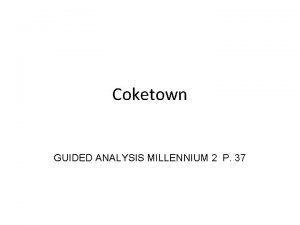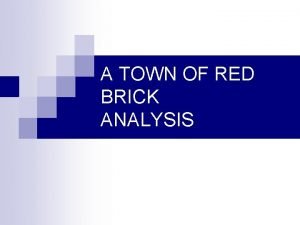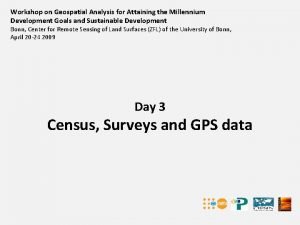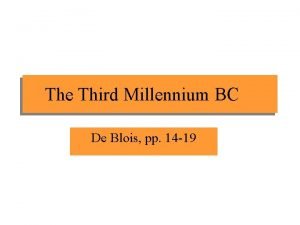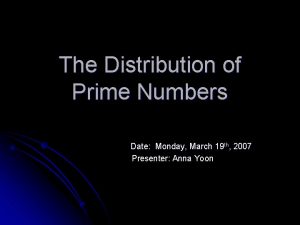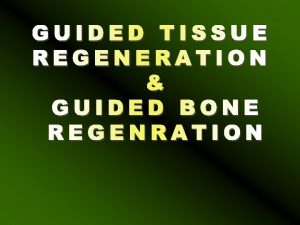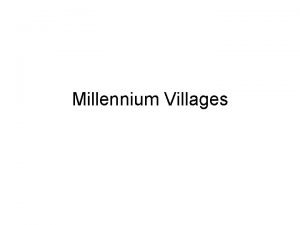Coketown GUIDED ANALYSIS MILLENNIUM 2 P 37 GUIDED




- Slides: 4

Coketown GUIDED ANALYSIS MILLENNIUM 2 P. 37

GUIDED ANALYSIS 1. What does the name Coketown suggest to you? • “coke” = black substance that is produced from coal and burnt to provide heat” (Oxford Advanced Learner’s Dictionary). • From the definition it can be inferred that ”Coketown” is representative of any industrial town in Victorian England. 2. List the features of the town and their distinctive elements, pointing out the metaphors and similes used by the authors. Features of the town: • Bricks: red and black because of smoke and ashes “like the painted face of a savage”; (ll. 1 – 3) • Factories: piles of buildings full of windows rattling and trembling; (ll. 7 – 8); machineries and tall chimneys, out of which “interminable serpents of smoke …. never got uncoiled”; (ll. 4 – 5) the piston of the steam engine worked monotonously up and down “like the head of an elephant in a state of melancholy madness”. canal: black; (l. 6); river: purple with ill-smelling dye; (l. 6); streets: large/small very like one another; (l 10 – 11);

2. people: equally like one-another, who all went in and out at the same hours … the last and the next (ll. 12 - 15); 3. Point out references to public buildings, describing their distinctive elements. What characterizes Coketown? Features of the public buildings: • Chapels: pious warehouses of red brick, sometimes with a bell tower like “a bird-cage”; (ll. 19 – 20); • The New Church: stuccoed, pinnacles “like florid wooden legs”; (ll. 2123) • Jail: might have been the infirmary; (ll. 24 – 25); • Infirmary: might have been the jail; (l. 25); • Town hall: might have been either, or both, or anything else; (ll. 25 – 26); • School: all fact (just like the maternity hospital and the cemetery). (ll. 29 – 32); • Coketown is characterized by its ugliness: everything is alike and equally unpleasant; life is monotonous in Coketown and workers’ life is hard; all the “material” aspects of the town (i. e. its buildings) and also the “immaterial “ ones (i. e. the relationships between its inhabitants) have been planned according to the principles of practical utility dear to the Utilitarians.

4. The only character named in the passage is “M’Choakumchild. Analyse his name and see how it fits with the overall description of the place. The name “M’Choakumchild” sounds as if it were made up of two words “Choke” (suffocating) and “child”. According to the “Oxford Advanced Learner’s Dictionary”, “to choke” means “ to make somebody unable to breathe”. Just like the polluted air of an industrial town suffocates the people, Mr Choakumchild kills his pupils’ spontaneity and creativity by basing his teaching methods on facts only. 5. The repetition of words, the choice of images, the description of buildings and people, all highlight Dickens’ point of view on industrialization. Re-read the passage and state the novelist’s position on the topic. • Dickens describes a typical Victorian industrial town where the air is polluted by smoke and ashes and pervaded by the poisonous smell from the canal and the river. The monotonous, melancholy and hard life of the people is reflected in the likeness between the town and its people and is emphasized by the repetition of such words as “all very like”, “equally like”, “more like”, “do the same”, “was the same”. • Dickens’ criticism is also highlighted by the choice of metaphors and similes (“the painted face of a savage”, “the head of an elephant in a state of melancholy madness”, “interminable serpents of smoke”) which recall a savage and primitive world. The passage is highly descriptive and is narrated in the third-person by an omniscient narrator whose choice of negative words is a way to impress his point of view on the reader. (143 words).
